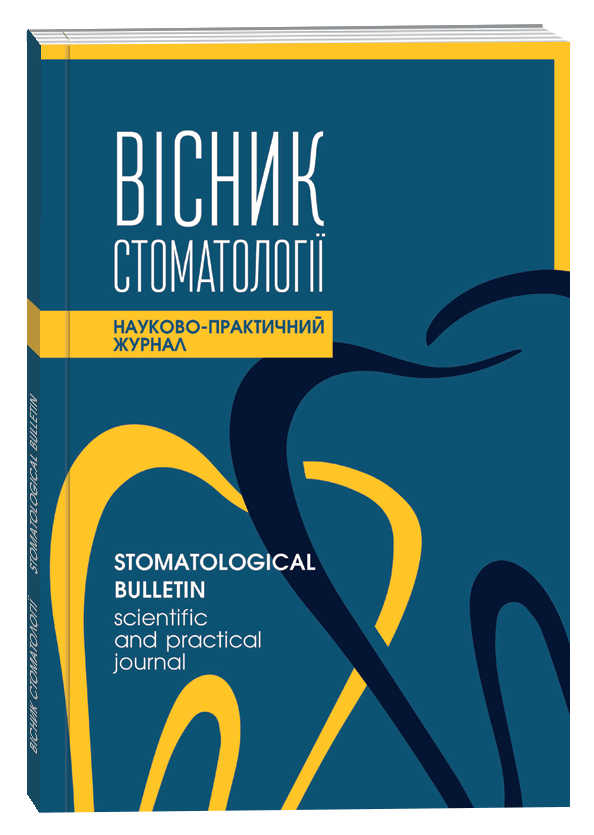FREQUENCY OF MALOCCLUSIONS AMONG SCHOOLCHILDREN
DOI:
https://doi.org/10.35220/2078-8916-2020-36-2-61-66Keywords:
children, malocclusions, prevalenceAbstract
Malocclusions are one of the main dental diseases and take second place after dental caries in the world. Ac-cording to the epidemiological studies of Ukrainian scien-tists, the prevalence of malocclusions in children from dif-ferent regions of Ukraine ranges from 24,43 to 83,33%, which indicates a significant variability of the data. The study of the prevalence of malocclusions, including dif-ferent nosological forms, is very important for the organi-zation of orthodontic care for children and the creation of a database on the incidence of the country. Therefore, the aim of the study is to assess the prevalence and structure of dental anomalies in schoolchildren.
Materials and methods of research. To study the preva-lence of dental anomalies, 1167 children of 6-16 years old were examined.
Results. It was found that the prevalence of malocclusions among examined children, on average, is 63,67±1,41 %. In 6-9-year-old children, the prevalence of malocclusions is 57,11±2,43 %, up to 10-12 years – the index increases to 66,23±2,71 %. Among the group of 13-16-year-old children, 68,01±2,21 % had orthodontic pathology. Two peaks of growth in the prevalence of malocclusions were established – 8 years (70,43±4,26 %) and 12 years (71,50±4,47 %). The results of the study show that, on av-erage, physiological occlusion was found in 36,33±1,41 % of cases. Еngle's class І anomalies were diagnosed in 44,30±1,45 %, class II anomalies in 16,03±1,07 %, while class III anomalies were diagnosed in only 3,34±0,53 % of children. Among children with malocclusion, class I anomalies according to Engle classification were found in 69,58±1,69 % of cases, anomalies of the II and III classes – in 25,17±1,59 % and 5,25±0,82 % of the examined per-sons.
Conclusions. Thus, assessing the prevalence of mslocclusions in children of different ages periods shows that from 6 to 8 years, the value of the prevalence of mal-occlusions increases significantly. In the period of 9-11 years, there is a tendency to reduce the percentage of people with malocclusion, which may indicate the pres-ence of self-regulatory processes during the eruption of premolars and canines. By the age of 12-16, the preva-lence of malocclusions increases slightly and remains at the level of 66,67 % - 71,50 %. A significant increase in the prevalence of malocclusions with the age was found only among children with class I anomalies according to Engle classification.
References
Алимский Л.В. Возрастная динамика роста рас-пространенности и изменения структуры аномалий зубоче-
люстной системы среди дошкольников и школьников / Л.В. Алимский // Стоматология. – 2002. - №5. – С. 67-71.
Аномалії зубних рядів в структурі зубощелепних аномалій у дітей 7-18 років / О.В. Суслова, Н.А. Железняк, Д.В. Стеценко [та ін.] // Вісник стоматології. – 2019. – №1, Т. 31. – С. 57-59.
Безвушко Е.В. Динаміка поширеності зубощелеп-них аномалій у дітей Львівської області / Е.В. Безвушко, А.Л. Міськів // Вісник проблем біології і медицини. – 2015. – Вип. 2, Т.2(119). – С. 21-24.
Бойцанюк С.І. Поширеність зубощелепних ано-малій серед дітей шкільного віку м. Тернополя / С.І. Бойца-нюк, М.М. Фалінський, П.Ю. Островський // Молодий вче-ний. – 2017. – №5(45). – С. 57-60.
Васильчук О.С. Поширеність карієсу зубів та зу-бощелепних аномалій у дітей 9-12 років Томашпільського району Вінницької області / О.С. Васильчук, Ю.В. Філімо-нов, А.В. Мартинюк // Вісник морфології. – 2016. – №1, Т. 22. – С. 155-158.
Мельник В.С. Поширеність і структура зубоще-лепних аномалій у дітей початкових класів м. Ужгорода / В.С. Мельник, Л.Ф. Горзов // Український стоматологічний альманах. – 2019. – №2. – С. 29-33. 7. Методичні рекомендації по статистичній обробці [уклад. Смоляр Н. І., Федорів Я. М. , Завойко Л. М. та ін]. Львів. –1995. – 17с.
Ославський О.М. Розповсюдженість та види зу-бощелепних аномалій у дітей м. Одеси / О.М. Ославський // Вісник стоматології. – 2010. – №1. – С. 38-40.
Потапчук А.М. Поширеність зубощелепних ано-малій серед дітей шкільного віку Закарпатської області / Потапчук А.М., Рівіс О.Ю., Зомбор В. // Проблеми клінічної педіатрії. – 2013. – №1(10). – С. 58-63.
Поширеність зубощелепних аномалій та мовлен-нєвих порушень серед дітей віком 6-12 років / П.С. Фліс, Н.В. Ращенко, В.В. Філоненко, А.О. Мельник // Сучасна стоматологія. – 2018. – №4. – С. 54-57.
Профит У. Современная ортодонтия /Уильям Профит; [перевод с англ. под ред. член.кор. РАМН проф. Л.С. Персин]. – М.:МЕДпресс-информ, 2006. – 560 с.
Смаглюк. Л.В. Порівняльна характеристика мор-фо-функціонального стану зубощелепної ділянки у пацієн-тів в період раннього та пізнього змінного прикусу / Л.В. Смаглюк., А.Є. Карасюк, М.В. Трофименко // Вісник про-блем біології і медицини. – 2016. – Вип. 2, Т.1(128). – С. 267-270.
Pattern of Malocclusion in Orthodontic Patients in South-Eastern Region of Nepal / Acharya A., Bhattarai B., George D., Bhagat T. // Orthodontic Journal of Nepal. – 2017. – №1,Vol. 7. – Р. 7-10.
Sabashvili M. Prevalence of malocclusion fmong 6-15-year-old children in Georgia: case report / Biomedical Jour-nal of Scientific & Technical Research. – 2018. – Volume 7, Is-sue 5. – P. 1-4.









